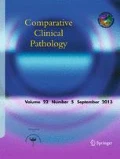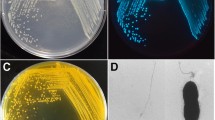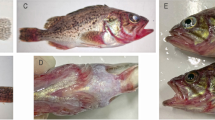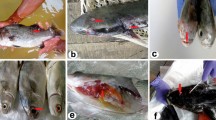Abstract
Vibriosis is one of the common bacterial diseases plaguing the prawn and shrimp industry. However, the sequential histopathological changes associated with Vibrio alginolyticus-induced vibriosis is scanty in literature. This study investigated the histological alterations in groups of Macrobrachium rosenbergii experimentally injected intramuscularly between the second and third abdominal segment with 50 μL of 107 CFU of V. alginolyticus. Twenty-four hours post inoculation, the organism was isolated and molecularly characterized while infected giant freshwater prawns were observed for histological alterations and immunoreactivity in different tissues due to the experimental challenge.
The lesions observed in the organs include incipient haemocytic infiltration into the interstitial space of the tubules of the hepatopancreas and loss of epithelial layer, muscular necrosis and disruption of muscular layer with haemocytic infiltration, hyperplasia of epithelial cells and degeneration of the epithelium, deformed and necrotizing lamellae, and enlargement of the lamellar sinus of the gill, and the heart is characterized by localized nodular haemocytic reaction and melanization. Organs such as the heart, gill, hepatopancreas and muscle following injection of the putative bacteria showed immunohistochemical activity. Hence, histology and immunohistochemistry still remain important tools for vibriosis disease diagnoses in giant freshwater prawns.














Similar content being viewed by others
References
Adams A (1991) Response of penaeid shrimp to exposure to Vibrio species. Fish Shellfish Immunol 1(1):59–70
Alday-Sanz V, Roque A, Turnbull J (2002) Clearing mechanisms of Vibrio vulnificus biotype I in the black tiger shrimp Penaeus monodon. Dis Aquat Org 48:91–99
Barman P, Banerjee A, Bandyopadhyay P, Chandra K, Kumar P, Mohapatra D (2011) Isolation, identification and molecular characterization of potential probiotic bacterium, Bacillus subtilis PPP 13 from Penaeus monodon. Biotechnol Bioinformatic and Bioeng 1(4):473–482
Bell TA, Lightner DV (1988) A handbook of normal penaeid shrimp histology (No. 595.3843 B4)
Bower SM, McGladdery SE, Price IM (1994) Synopsis of infectious diseases and parasites of commercially exploited shellfish. Annu Rev Fish Dis 4:1–199
Brock JA, Lightner DV (1990) Diseases of crustacea. Diseases caused by microorganisms. Dis Mar Anim 3:245–349
Chen SN, Huang SL, Kou GH (1992) Studies on the epizootiology and pathogenicity of bacterial infections in cultured giant tiger prawns, Penaeus monodon in Taiwan, Diseases of cultured penaeid shrimp in Asia and United States. The Oceanic Institute, Hawaii, pp 195–205
Collins P (2010) Environmental stress upon hepatopancreatic cells of freshwater prawns (Decapoda: Caridea) from the floodplain of Paraná River. Nat Sci 2(7):748–759
Evensen Ø, Lorenzen E (1996) An immunohistochemical study of Flexibacter psychrophilus infection in experimentally and naturally infected rainbow trout (Oncorhynchus mykiss) fry. Diseases of Aquatic Organisms, 25(1–2), 53–61
Ferreira T, Rasband W (2012) ImageJ user guide IJ 1.46r. ImageJ/Fiji 1.46 Revised Edition
Flegel TW (2012) Historic emergence, impact and current status of shrimp pathogens in Asia. J Invertebr Pathol 110(2):166–173
Gomez-Gil B, Tron-Mayen L, Roque A, Turnbull JF, Inglis V, Guerra-Flores AL (1998) Species of Vibrio isolated from hepatopancreas, haemolymph and digestive tract of a population of healthy juvenile Penaeus vannamei. Aquaculture 163(1):1–9
Jayaprakash NS, Pai SS, Philip R, Singh ISB (2006) Isolation of a pathogenic strain of Vibrio alginolyticus from necrotic larvae of Macrobrachium rosenbergii (de Man). J Fish Dis 29(3):187–191
Kennedy B, Venugopal MN, Karunasagar I, Karunasagar I (2006) Bacterial flora associated with the giant freshwater prawn Macrobrachium rosenbergii, in the hatchery system. Aquaculture 261(4):1156–1167
Khuntia CP, Das BK, Samantaray BR, Samal SK, Mishra BK (2008) Characterization and pathogenicity studies of Vibrio parahaemolyticus isolated from diseased freshwater prawn, Macrobrachium rosenbergii (de Man). Aquac Res 39(3):301–310
Lavilla-Pitogo CR, Leaño EM, Paner MG (1998) Mortalities of pond-cultured juvenile shrimp, Penaeus monodon, associated with dominance of luminescent vibrios in the rearing environment. Aquaculture 164(1–4):337–349
Lightner DV (2012) Biology and pathology of early mortality syndrome of shrimp, vol 40. Global outlook for aquaculture leadership, Bangkok
Lightner DV, Redman RM (1998) Shrimp diseases and current diagnostic methods. Aquaculture 164:201–220
Liu C, Chen JC (2004) Effect of ammonia on the immune response of white shrimp Litopenaeus vannamei and its susceptibility to Vibrio alginolyticus. Fish Shellfish Immunol 16(3):321–334
Longshaw M (2011) Diseases of crayfish: a review. J Invertebr Pathol 106(1):54–70
Mehdi R (2011) Molecular detection of Vibrio spp. in lobster hemolymph. Afr J Microbiol Res 5(13):1697–1700
Noraini O, Jahwarhar NA, Sabri MY, Emikpe BO, Tanko PN, Latifah MH, Jamil S (2013) The effect of heat stress on clinicopathological changes and immunolocalization of antigens in experimental Streptococcus agalactiae infection in Red hybrid tilapia (Oreochromis spp.). Vet World 6(12):997–1003
Poupard JD-B, W C (1976) Disease problems of prawns in recirculation systems in the U.K. Aquaculture 7:201–217
Prakash M, Karmagam N (2013) A study on bacterial flora associated with fresh water prawn, Macrobrachium rosenbergii. Int J Curr Res Acad Rev 1(1):1–6
Saulnier D, Haffner P, Goarant C, Levy P, Ansquer D (2000) Experimental infection models for shrimp vibriosis studies: a review. Aquaculture 191(1–3):133–144
Sayuthi S (1993) Fish diseases in Malaysia: status and problems . Proceedings of the Aquaculture Workshop for SEAFDEC/AQD Training Alumni, 8- 11 September 1992, 56–61
Tyagi A, Khushiramani R, Karunasagar I, Karunasagar I (2007) Antivibrio activity of recombinant lysozyme expressed from black tiger shrimp, Penaeus monodon. Aquaculture 272(1–4):246–253
Vaseeharan B, Ramasamy P (2003) Control of pathogenic Vibrio spp . by Bacillus subtilis BT23 , a possible probiotic treatment for black tiger shrimp Penaeus monodon. Lett Appl Microbiol 36:83–87
Zorriehzahra MJRB (2014) Review article. Adv Anim Vet Sci 3(2)
Author information
Authors and Affiliations
Corresponding author
Rights and permissions
About this article
Cite this article
Ajadi, A., Sabri, M.Y., Atata, J.A. et al. Pathology and immunohistochemical evaluation of Vibrio alginolyticus infection in Macrobrachium rosenbergii. Comp Clin Pathol 28, 359–368 (2019). https://doi.org/10.1007/s00580-018-2881-4
Received:
Accepted:
Published:
Issue Date:
DOI: https://doi.org/10.1007/s00580-018-2881-4




